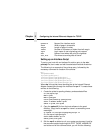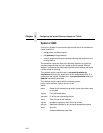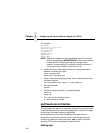
BSD UNIX
161
The control file usually contains valid information about originating user
and host. The contents are only used to gather log information on the
printed jobs. Since the control file may not arrive before the data file in
the current LPD standards, fully detailed banners cannot be
guaranteed.
Setting up Ipd Remote
To add an Internal Ethernet Adapter as a remote printer entry on your
BSD UNIX host, you need to add an entry to the /etc/printcap file and
create its associated file and directories. The following is an example of
what the printcap should look like, with a description of the commands
necessary to create these entries:
ps|PostScript printer on spike’s prn port:\
:lp=:\
:rp=d1prn:\
:rm=spike
:sd=/usr/spool/lpd/spike/ps:\
:lf=/usr/spool.lpd/spike/ps/log:\
:af=/usr/spool.lpd/spike/ps/acc:
Where ps is the printer name sending jobs to the destination d1prn on
the Internal Ethernet Adapter named spike.
To create the necessary entries for this example, use the following
commands:
cd /usr/spool/lpd
mkdir spike
mkdir spike/ps
touch spike/ps/log spike/ps/acct
chown -R daemon.daemon spike
chmod -R g+rwX,o+rX spike
You can then start this printer.
lpc start ps
To send a job, use this syntax:
lpr -P
printername filename
BSD Interface Script Printing
If you choose not to use a remote printer setup, you can use an
interface file. This interface script is specified in /etc/printcap with the
if= entry rather than the rm= and rp= entries. This script is called by the
lpd daemon with the following syntax:
nprbsd.if -w
width
-l
length
-i
indent
-n
login
-h
host acct_file
where


















